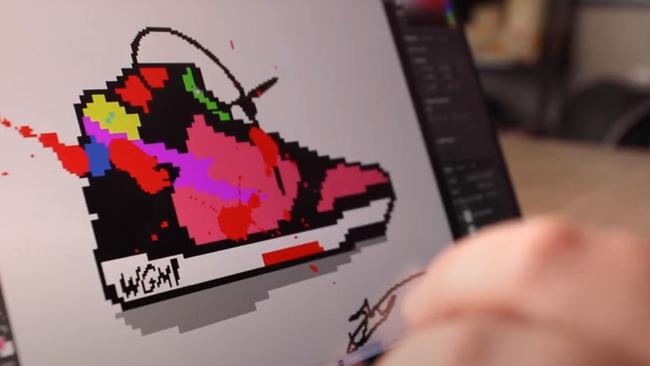How to make an NFT and make money doing it: Artist Joan Westenberg
Beauty is in the eye of the beholder when it comes to the world of NFTs.

Joan Westenberg owns a non-fungible token, a Mutant Ape, now worth about $85,000 and has made thousands of dollars from selling her own NFTs in the past few months.
But the tech worker, artist, musician, sometime journalist, angel investor and start-up founder says she jumped into the world of Ethereum, block chain and smart contracts late last year because it looked like fun.
“I thought, this is something new,” says the 33-year-old, who can now add crypto artists to her resume.
“I’m an early adopter of pretty much anything and everything. I wanted to know what it felt like. I just want to know what it’s like to be a part of different movements and ideas and try them out.”

Westenberg has a day job – on a user platform that helps musicians create NFTs – and she’s not looking to make a killing with her art. She won’t reveal how much she’s made but says it “eclipses” her pre-pandemic income. But she is interested in the politics of NFTs and how they push back against the way the internet has devalued everything from news to original music.
“I think, in the early 2000s, we did have ideas of digital ownership,” says Westenberg.
“You were buying a song on iTunes or buying a movie file, but we’ve now got Netflix and Spotify and people don’t own content anymore, they just rent it. And that to me, is quite a shame.”

Sitting in her high-rise apartment in Sydney’s inner west, she opens her laptop to demonstrate how to make and sell NFTs – the unique products that can’t be rented or copied – in the cryptocurrency space that is opening new global markets for Australian artists.
Westenberg says her three loves are writing, music and technology. She taught herself to code at 11, taught herself to play the bass, taught herself to write stories.
“Along the way, I explored every creative angle I possibly could, whether it was drawing little comics, or designing merch for bands, touring around in my own band,” she says.
“But I kept on running up against how difficult the world is for creatives, it’s brutal. There are layers, like Spotify and Netflix, that sit between creators and consumers and build layers of destruction.
“I felt everything was stacked against creators.”
NFTs were created in 2017 but boomed last year, which was when Westenberg finally saw their potential: “I suddenly thought, why should a piece of art only have value if it’s on a canvas? Why shouldn’t it have value if it’s on a screen? And at that point, everything just clicked. It was like, wow, there actually is a way to assign value to and trade a piece of art that has only existed digitally.”
She had been drawing pixelated versions of the famous Nike Dunk for years and as a “shoe collector” decided her Dunk Punk series – which till then had a limited outing on postcards and Instagram – would go well as NFTs.
She chose a peer-to-peer marketplace called OpenSea, using one of its templated smart contracts to “mint” her tokens.

She opted for a set price for each piece – which can vary with the value of the Ethereum currency from between $150 and $170 – and wrote into her contract that she would receive 8.5 per cent each time a piece was on sold.
The Dunks for Punks pieces sold well and Westenberg quickly added another digital series, Riot Grrrls, to the OpenSea platform. Then she launched The Presidents – a series of collages built with code which suggest most American leaders wind up looking the same, whether they are from the left or the right - on the Solana platform. She also sells other pieces of her work on the platforms.
She bought her Mutant Ape Yacht Club token last year and it has tripled in value. The series by Yuga Labs began as images but the NFTs now work as entree to video games, merchandise, events and community groups. That extra value has been created by Yuga as well as other community members who build elements into it.
Westenberg’s day job is with the technology platform and community called MODA DAO (decentralised autonomous organisation). It has several thousand members and Westenberg is one of the core team of 10.
The buzz is huge but will NFTs last or pass?
Says Westenberg: “Whenever there’s anything new, there’s a spike in interest and everyone goes crazy. Sooner or later that bubble pops. This is probably going to be similar to the dot.com era … these things pop but that doesn’t mean that they end, they evolve.
“There are a lot of people who look at a Rothko painting, and say, well, that’s just some lines on canvas, that shouldn’t be worth millions. The same argument gets made about pixels. But, ultimately, why should a diamond be worth as much as it is?
“I’m not what I would call a maximalist. I don’t think that NFTs are the be-all and end-all. But I think it’s great that we have an option for valuing and selling digital goods.
“When you are selling your work, you should be able to sell it as a digital file as well as a canvas if you want to. If you’re an artist starting out today, you would want to have a lot of different formats.”
Westenberg says owners “do all kinds of stuff with NFTs”: some have virtual reality galleries where they can display their digital art; some display them on their Apple Watches. She says big brands can easily come unstuck when they try to make NFTs as a “cash grab” and cites the NFT made by Pepsi, the Pepsi Mic Drop, issued late last year as “one of the worst things I have ever seen”.
“And it’s because they haven’t really started with understanding what the space is, or what the community is or what people actually want,” Westenberg says. “It’s always kind of terrible.”




